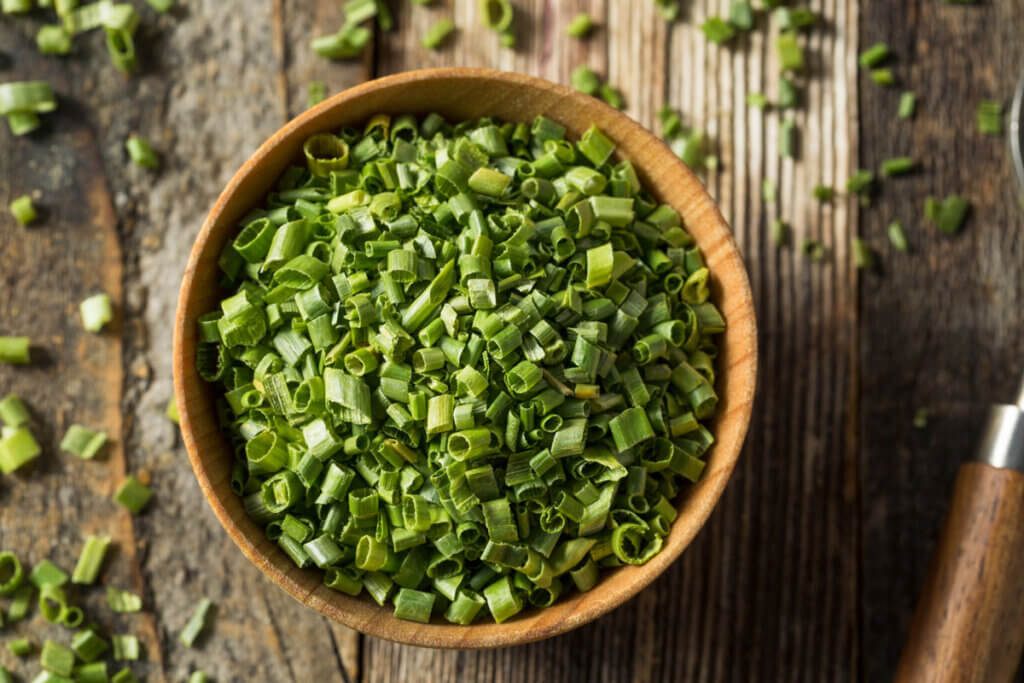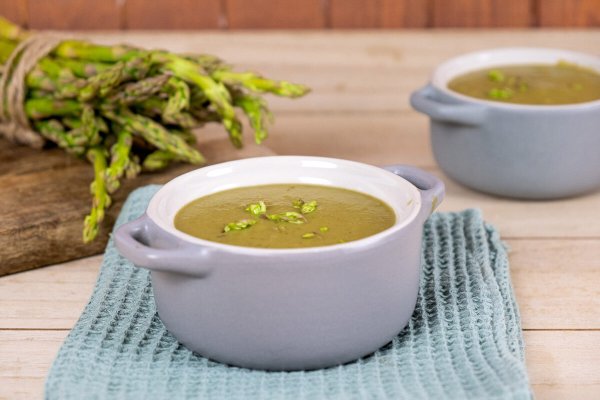Chives are a perennial herb that adds a delicious garlic-onion fusion to potatoes, salads, eggs and more. But did you know chives’ nutritional benefits classify them as a superfood? Use this guide to learn the health benefits of chives, various ways to use them, how to grow them from seed in an indoor pot (or outside in your garden), and much more!

Why You Should Learn How to Grow Chives
I grow a variety of culinary herbs in my cottage garden. Many have gorgeous blooms which attract pollinators to the garden and work as great companion plants to deter pests and improve the soil.
When growing basil, parsley or cilantro, I have to wait until later in the growing season before they are ready. On the other hand, chives are a cool-weather crop, so they are among the first herbs to be ready in the spring and will return for a second harvest in the fall.
And, like growing peppermint and growing sage, chives are a perennial allowing you to plant just once and enjoy year after year.
For these reasons, learning how to grow chives is a great choice when implementing strategies to successfully extend the growing season to grow a year’s worth of food.

Varieties of Chives
Several varieties of chives can be grown easily in your garden; here are a few to choose from:
- Common Chives – As the name implies, common chives (Allium schoenoprasum) are the most common variety of chives grown. They have beautiful purple-colored blooms and tubular blue-green leaves that taste like onion with a hint of garlic.
- Chinese Chives – Chinese chives or garlic chives (Allium tuberosum) look similar to common chives with a more robust garlic flavor. It grows taller and has a flat green leaf with white flowers.
- Giant Siberian Chives – Giant Siberian chives (Allium ledebourianum) have a strong, rich onion flavor and grow tall with rose-violet flowers.
- Siberian Garlic Chive – Siberian garlic chives (Allium nutans) have an onion-garlic flavor similar to the common chive. It grows blue-green leaves with pink flowers.

Health Benefits of Chives
It’s important to note that I am not a certified medical practitioner. This post is not intended to diagnose or treat but is for informational purposes only. Please contact your medical care professional before introducing new herbal remedies into your wellness routine.
To say that chives are good for you is an understatement. Chives are rich in plant-based antioxidants, flavonoids, and dietary fiber, providing your body with the support it needs to function optimally.
- Eyes – Chives contain carotenoids which accumulate in the retina of the eye protecting it from macular degeneration which is the leading cause of blindness in developed countries. (Source)
- Bones – There are compounds in chives to help the body retain calcium and support the production of osteocalcin to help maintain mineral density in the bones. (Source)
- Digestion – Studies have concluded that the anti-inflammatory compounds of vegetables in the allium family improve disorders associated with the digestive system. (Source)
- Cancer Protection – Studies agree that vegetables from the allium family containing sulfur compounds and antioxidant properties work to prevent cancer, and have been further studied to determine the benefit during various stages of cancer. (Source)
- Sleep – Chives contain choline which has been linked to improving sleep function. (Source)
- Immune System – Chives contain both antifungal and antimicrobial properties that aids in reducing the effects of nitro-oxidative stress, protecting from various diseases and premature aging. (Source)

Ways to Use Chives
Both the leaves and flowers of chives are edible. You can use chives in various foods, infusing a mild garlic and onion flavor to your favorite dishes.
- Eggs – Chives pair well with egg dishes like this flexible frittata recipe. It’s a delicious garnish on deviled eggs and a great addition to classic scrambled eggs or an omelet.
- Bread – Adding chopped chives to an herbed flatbread is a great variation to my no-knead bread dough.
- Salads and Dressings – When you grow fresh greens year-round, it’s nice to have fresh herbs on hand to add diversity to green salads. Or, try adding fresh chives to this homemade vinaigrette dressing.
- Sauces – Chives are a flavorful addition to quick and easy pan sauces adding a subtle garlic and onion flavor.
- Ferments – Chives ferment well, adding flavor to fermented tomatoes and fermented green beans.
- Canned Foods – Are your canned foods tasting a bit dull? Try adding some fresh chives, which can bring them to life with great flavor.
- Main Dishes – We enjoy the flavor of chives in soups, stews and garden stir fries. Homesteading Hack: Add your fresh or dehydrated chives at the end of your cooking time for the best flavor.
- Herbs Blends – Chives enhance a variety of homemade herb blends such as ranch seasoning, Italian seasoning and homemade garlic salt.
- Substitution – You can substitute chives in many recipes that call for onions due to their similar flavor. My easy meatloaf recipe and my family’s favorite pizza pepper poppers taste great with chives instead of onions.

How to Grow Chives
Chives are easy to grow, and they multiply quickly. They are hardy in zones 3 through 10 and can winter inside for year-round use. If you have a neighbor or friend with chives, get a start from them (a small portion of the plant and roots) and plant in late spring or early summer.
Chives grow well in containers, rock gardens and vegetable and herb gardens. They’re also deer resistant!
Planting
- Seeds – Chives are easy to start from seed indoors or can be sown directly into the soil if needed. It’s best to familiarize yourself with the varieties and learn how to read seed packets if you plant chive seeds. Homesteading Hack: Plant your chive seeds indoors weeks before the last frost, and pot up your seedlings before planting in the ground. This combination will give your chives a good, solid start.
- Soil – Chives prefer well-drained, loamy, sandy soil with a pH of 6.5 to 7.5 (neutral). Testing your soil pH is easy and will give you the information needed to grow chives in prime soil conditions.
- Spacing – Space your chive plants 12” to 18” apart, allowing the plant good air circulation to help prevent powdery mildew and spider mites. Chives don’t do as well if the soil is dry; keeping the ground moist but not soggy is best.
- Sun – Chives are hardy and prefer 6 to 8 hours of sunshine. When the soil dries out, or the plant becomes partially shaded, they are adaptable and will continue to thrive.
- Companion Planting – Chives do well when planted alongside carrots, tomatoes, garlic, and other nightshades. They’re great at repelling flies, mosquitos and aphids.

Growing
- Watering – Once you have them in a sunny location in well-draining soil, water them as needed to keep the soil damp but not soggy.
- Fertilize – We make homemade compost, adding it to the potting mix and again to the soil when planting in the ground. Homemade compost or compost tea is sufficient for most garden plants, especially herbs like chives. It’s best to add a side dressing of compost to the plants in early spring and gently work it into the soil around the plant to ensure the plant has adequate nutrients.
- Mulch – To keep weeds away and retain moisture, spread some wood chips, pine straw or a preferred mulch around the base of the chive plant. Keep it watered and pick out any dead leaves for more substantial growth.

Harvesting
Whether you plant chives in a container or sow them in your garden, you can harvest them many times in their first year of planting. The more established the plant, the more you can harvest and enjoy chives throughout the year.
- Harvesting – Give them 30-60 days before harvesting if a first-year plant. You can harvest older, established plants when the leaves reach 8-10 inches in height. Cut off the flower buds before they bloom to promote more vigorous growth.
- Cutting Chives – Use sharp scissors or small pruning shears throughout the growing season and cut the leaves back within 2-3 inches of the soil. The chive plant’s small purple flowers and stalks are edible but less tasty. This plant will not survive a hard freeze; it’s best to propagate some and put it in a container to bring inside for winter use.
- Storing – Fresh chives are best; they store well when wrapped in paper towels and placed in the refrigerator. Keeping them in an airtight container gives the best results for future use.

Preserving
Because I prefer fresh chives, I don’t always preserve them. However, if I am preserving them, my go-to method is the freeze-dryer. It maintains that fresh chive flavor much better than other preservation methods.
Here are a few options if you choose to preserve your chive harvest:
- Dehydrated – Chives dehydrate extremely well and make a beautiful garnish for savory dishes. However, dried chives don’t maintain their flavor as well. Store in glass jars with a tight-fitting lid for long-term storage, and keep your dried chives in a cool place on your pantry shelf.
- Freeze Drying – Understanding the difference between freeze drying and dehydrating is important. Unlike dehydrating chives, freeze-drying chives will preserve fresh chives’ flavor, color, and texture. For long-term storage, store freeze-dried chives in vacuum-sealed glass jars.
- Freezing – Freezing herbs is another great way to preserve the flavor of chives and add to your favorite soup, stew or sauce recipe.
- Salt – Herbs preserved in salt would also work well for chives. Not only will it help maintain that strong chive flavor, but you’ll have a by-product of delicious herbed salt.

Homestead Permaculture
As you can see, chives are a wonderful addition to the homestead providing various uses in the kitchen while benefiting the overall ecology of your garden.
If you want to learn more about getting the most out of your homestead and garden, we invite you to join us in the Permaculture for Your Homestead Workshop.
This FREE 50-minute video crash course will teach you how permaculture can make your homestead, garden and home produce more with less effort. Sign up to get instant access today!

















